Empower the Workforce With A Culture of Peer-to-Peer Recognition
People who work in an environment where doing their best is recognized have a better chance of feeling good about their work.
- Marilyn Suttle
Human nature has always gravitated towards seeking acceptance and appreciation in the surroundings that one works in. Despite this behavioral trait, peer-to-peer recognition is often ignored in favor of the more popular top-down recognition. But how do you build a culture that focuses on 360-degree recognition?
The answer is simple, yet we tend to ignore it. And to shed light on this very critical topic, we will go through it in this article.
Let's delve in.
Key Takeaways
- Understand the importance of peer-to-peer recognition.
- Explore the benefits of peer-to-peer recognition.
- Have a thorough understanding of the different ideas of peer recognition.
- How to implement a peer recognition program.
- Platforms that work best for peer recognition.
What is Peer-to-Peer Recognition?

Peer-to-peer recognition is the expression of appreciation for a job well done by colleagues within an organization. The major advantage of this type of recognition is its flexibility. The practice has no limitations, be it your team members or someone from a cross-functional team.
But how does it work?
In the simplest ways, you can show appreciation for a project the team members finished or help out colleagues during a difficult period. Even a tiny act of kindness, like thanking a colleague for assisting you with the presentation, can brighten their day. A culture that emphasizes peer recognition can eventually increase morale and engagement.
The Importance of Peer-to-Peer Recognition!

The idea of recognition starts from the leadership level. Being the leader, you have to take the initiative to inject the practice of peer recognition by acting on it and guiding the workforce. And you need to be consistent with it to understand the different dynamics. When you delve deeper into what peer-to-peer recognition offers, you see a vast pool of opportunities to uplift the workforce.
But how important is it?
When asked what leaders could do more to increase engagement, 52% said, "give recognition." Ensuring productivity remains intact while boosting the employees' confidence is crucial.
The bigger picture is that the need for peer-to-peer recognition will only increase with time. As a leader, you must strategize and keep changing your efforts to leverage the benefits.
You need to know this, and so does the workforce. The very idea of the program is to indulge them in appreciating each other instead of the usual top-down recognition.
What Are The Benefits of Peer-to-Peer Recognition?
There are numerous benefits of peer-to-peer recognition that one can explore. Here are a few that are the most important for an organization.
1. High Morale and Motivation!
Keeping in an employee's perspective, when their co-workers appreciate them, it adds value. It showcases an employee's importance among the team members.
In the long run, this helps to improve morale and motivation within the team. Moreover, it encourages them to go above and beyond for the team.
Read more: Unlocking Employee Motivation- A Comprehensive Guide
2. Good Employee Relationship
Peer-to-peer recognition is one of the main drivers behind building good relationships in the workplace. When employees acknowledge each other for their work, trust and understanding develop. This is an essential factor that helps businesses maintain good team dynamics.
In the long run, it helps create a well-balanced team that performs well and delivers results.
3. Improved Job Satisfaction
46% of US workers leave their jobs because of a lack of appreciation. The figure demonstrates how important it has become to appreciate employees' efforts. When employees do not receive the necessary appreciation from their colleagues for their efforts, it demoralizes them. It creates a lack of enthusiasm, and they do not feel the need to go above and beyond every time.
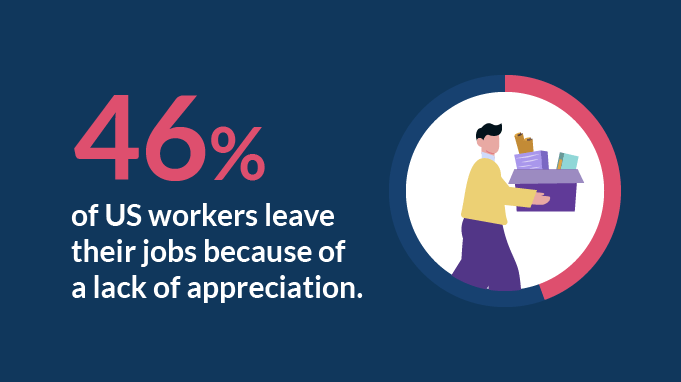
However, this phenomenon can be avoided with a good peer-to-peer recognition program. Employees feel satisfied with their work when they receive praise from their co-workers. It enables the employees to feel more connected with their job and enjoy their responsibilities. This ensures that job satisfaction remains on the higher end of the spectrum.
Recommended Read: An All-In-One Guide To Boost Employee Job Satisfaction
4. Elevated Employee Confidence!
98% of employees say they perform better when they feel confident. And it's true. You might have experienced the same. You tend to perform better when you feel confident about your skills and responsibilities.
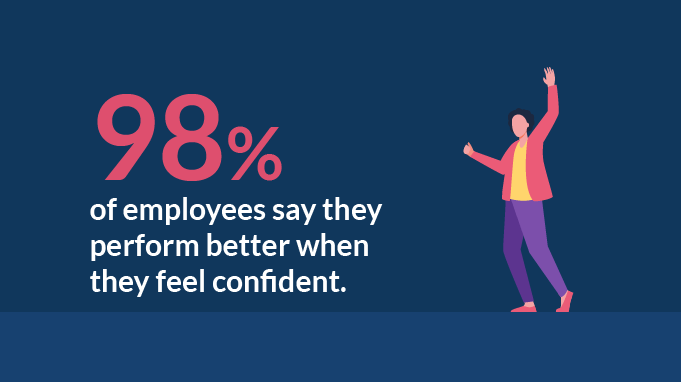
The problem is that people will not know "if" they are doing a good job when nobody tells them so.
But with social recognition, you can do that without any hassle. Ensure that you have a system that allows the employees to appreciate each other socially. With this, the employees can acknowledge their peers for a good job. This will also enable them to recognize their peers within the organizational communication channel.
In the long run, it will impact the employees' confidence who receive the appreciation socially. And also encourage the rest of the workforce to do well in their jobs.
5. Promotes Team Spirit
Approving peers' skills and competencies is essential to a functional team. This shows that they respect each other and acknowledge the capabilities of the team members.
You can further assist the employees in projecting that feeling with the help of peer-to-peer recognition. Give the employees the freedom to appreciate their peers when they see someone doing a good job or helping someone out.
This will not only improve their understanding of each other but will also help in improving engagement.
Read more: 5 Ways to Encourage Team Spirit
6. Increased Work Performance!
69% of employees say they would work harder if they were better appreciated. And numbers don't lie. With such a high percentage of employees, it becomes evident that appreciation is the key to improving performance.
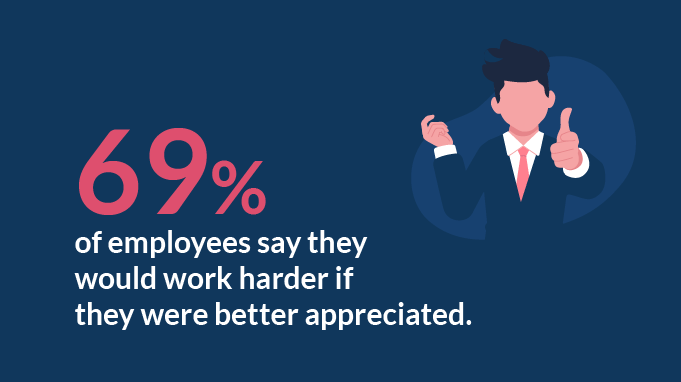
Apart from the top-down recognition, when employees indulge in appreciating each other adds personal value. Doing so motivates the employees to do better and improves work performance in the long run.
Peer-to-Peer Recognition Ideas That Work

Peer recognition does not take much effort. It's the simple things that matter the most, and below is a list of some ideas that work.
1. Create a Video

One great idea under peer-to-peer recognition is creating a video for an employee. You can assign the responsibility to one of the peers. The assigned co-worker will ask the team members to say a few words of appreciation.
Once everything is done, send the video to the employees' mail or gather around the team and play it in front of everyone.
2. Point-Based Peer Awards

Another great peer-to-peer recognition idea is to have point-based peer awards. For this, you need to enable a system that authorizes the employees to give away points while appreciating their peers.
And you can do it with Vantage Circle's AI-powered recognition platform. With the platform, you can set the desired budget for your employees and assign specific roles within the team. Once everything is set, the employees can start appreciating their peers while incentivizing the awards with points.
3. Physical Display Boards

The idea of a physical display board will require a little investment. But it will enable you to recognize an employee who performed well socially. This will also encourage other employees to congratulate the employee with the help of sticky notes or congratulatory cards. Thus increasing the overall peer-to-peer recognition in the workplace.
4. Team Huddle

Take time to recognize the employees for a well-done job by doing a team huddle. Give the authority to one of the employees of the team member to organize the huddle. It will make them feel more involved in the entire appreciation process. Moreover, everyone on the team can contribute a small token of appreciation for their peer.
5. Cross-Department Appreciation

The cross-departmental appreciation is another great peer-to-peer recognition idea that works. Good relationships are formed when employees from different departments thank each other for their contributions.
And the employees can do it with the social feed feature of Vantage Circle. When a peer appreciates their fellow workers using the social feed, everyone in the organization is notified about it. This enables the other employees to join in and comment on the post, making the appreciation more meaningful and relevant.
6. Feedback Platforms

In the realm of fostering peer-to-peer recognition, digital platforms have emerged as indispensable tools that effortlessly bridge gaps and facilitate meaningful connections among colleagues. These platforms provide a virtual space where individuals can readily exchange ideas, commendations, and feedback, transcending traditional hierarchies.
7. Peer-to-Peer Learning Sessions

Recognize expertise by allowing peers to host learning sessions or workshops on topics they excel in. This encourages knowledge sharing, which benefits the organization in the long run. Moreover, it also promotes diverse learning within the workforce.
8. Recognition Badges

With things shifting on the virtual front, you can Implement a digital platform where employees can award badges to their peers for various achievements, be it "Team Player," "Creative Genius," or "Above & Beyond."
Recognition badges within digital platforms have revolutionized how peer-to-peer appreciation is expressed and celebrated.
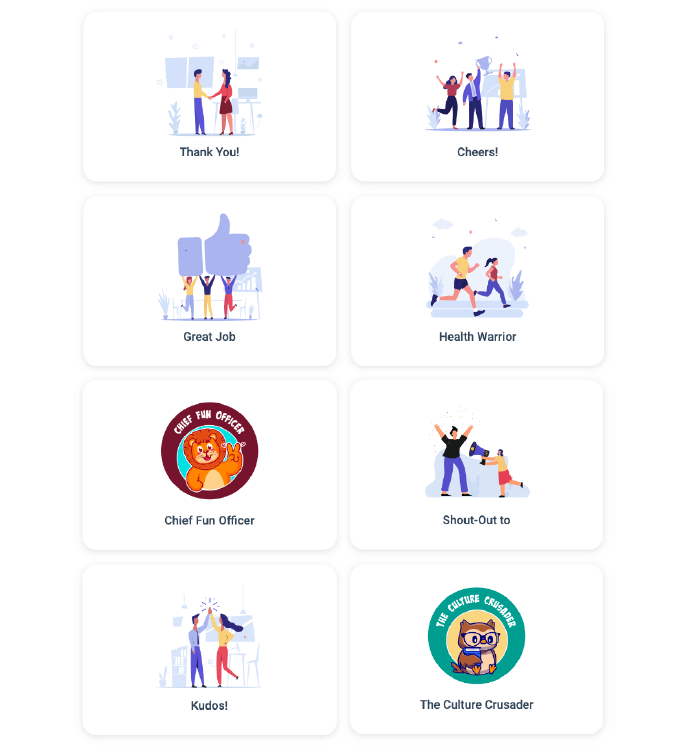
(Source: Vantage Circle)
These virtual badges serve as tangible representations of accomplishments and acts of recognition, allowing colleagues to publicly acknowledge each other's achievements.
9. Peer Nominated Awards

Each month, have employees nominate a colleague for an "Employee of the Month" title based on teamwork, innovation, or other criteria. This award can come with small perks like a parking spot or a gift card.
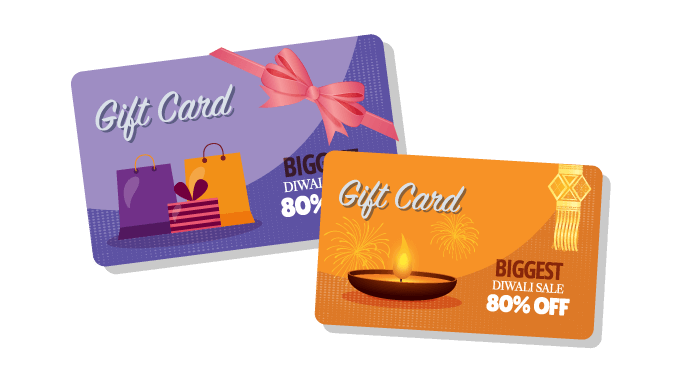
This collaborative approach not only empowers employees to actively engage in recognizing their peers but also fosters a sense of ownership and inclusivity.
10. Thank You Cards
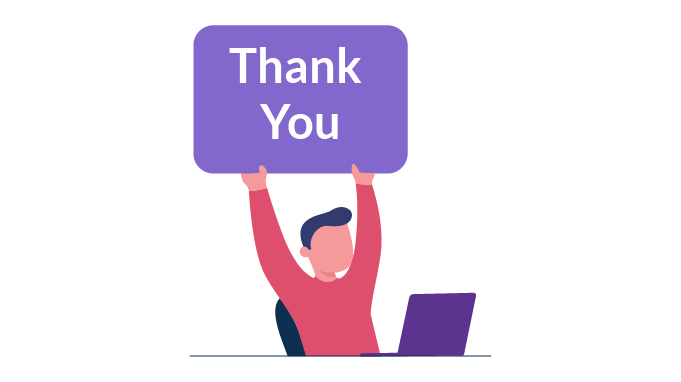
You can also encourage employees to write thank you cards or notes to their peers when they feel someone has done something noteworthy. These could be physical cards or digital messages with the help of digital platforms.
Best Practices of Peer-to-Peer Recognition That Are Effective

You now have a fair idea of the ideas/examples of peer-to-peer recognition. But what are some of the best practices that really make it impactful? Here is a list that we think can help you in the long run.
1. Recognition Should be Immediate

When it comes to peer-to-peer recognition, timing is everything. It is only effective when done in the 'moment.' And that is what you have to educate the employees about efficiently. You need to tell them how timing is important while appreciating a colleague.
To make things easier, here is a simple example.
Assume a colleague or employee completes a difficult task after a week of hard work. They were recognized months after the project was completed. This does not have the same significance. As a result, the late appreciation loses its actual value.
However, when colleagues recognize their peers for a job well done, it has a positive impact overall. It boosts their morale and gives them a sense of accomplishment. The employees can practice it by-
-
Recognizing the employee immediately following a significant accomplishment.
-
Appreciating them for their efforts will boost their confidence.
2. Be Specific About Your Recognition

Every employee wishes to be recognized for their efforts. It gives them the necessary drive to go above and beyond in their next task. But why are they being noticed?
Specificity is a critical factor, and the employees need to understand that. They cannot just go about appreciating their peers.
While appreciating, when employees are specific about it, the receiver better understands why they are getting the appreciation. They will be able to comprehend what they did right for the team. The recognition should be straightforward from the peer's end. This makes it more meaningful and impactful. And in the long run, it assists a colleague in improving focus on their responsibilities. To be more specific, you can-
-
Mention the reason for the praise.
-
Display the report on the things that made a difference.
3. Maintain Consistency
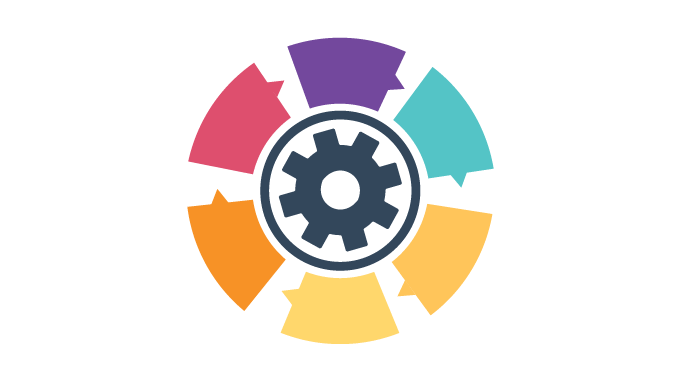
We've all heard that 'consistency is the key' to success. The same can be said for peer-to-peer recognition.
Peer recognition is more than just a single day of praise and appreciation. It should be done repeatedly and consistently. And this is what the employees have to acknowledge in the long run.
When employees recognize their peers for their sake, it undermines the entire recognition concept. That can hurt the outlook of the recognition program.
To make things interesting, you can incentivize the entire recognition program. For example, when an employee appreciates their peer for a successful marketing campaign, you can give them points. This will maintain the employees' enthusiasm, and they will be more involved in the program.
Ensure that you use a program that is easily accessible and customizable. One such platform worth exploring is Vantage Circle, a trailblazing solution driven by AI-powered technology. This rewards and recognition program operates within a cloud-based environment, accommodating the modern work landscape's dynamic needs.
What sets Vantage Circle apart is its high level of customization, allowing organizations to tailor the platform to their specific preferences and branding.
4. Go Virtual!

The need for a virtual peer-to-peer recognition system has become critical in today's ever-changing and constantly evolving business environment. One of the prime factors that increased the need for a virtual system was the onset of the COVID-19 pandemic.
The pandemic changed the entire scenario of how workplaces operated with the immediate implementation of work from home. This sudden change raised concerns like-
-
How to praise fellow employees?
-
What can a manager do to improve engagement while working remotely?
-
What is the scope of a leader to opt for a virtual engagement system with easy accessibility?
All these concerns had one simple yet effective solution: a cloud-based employee recognition software. These recognition tools are easily available and provide simpler functionality for anyone in the organization.
And one such system is Vantage Circle, your one-stop solution for all employee engagement needs.
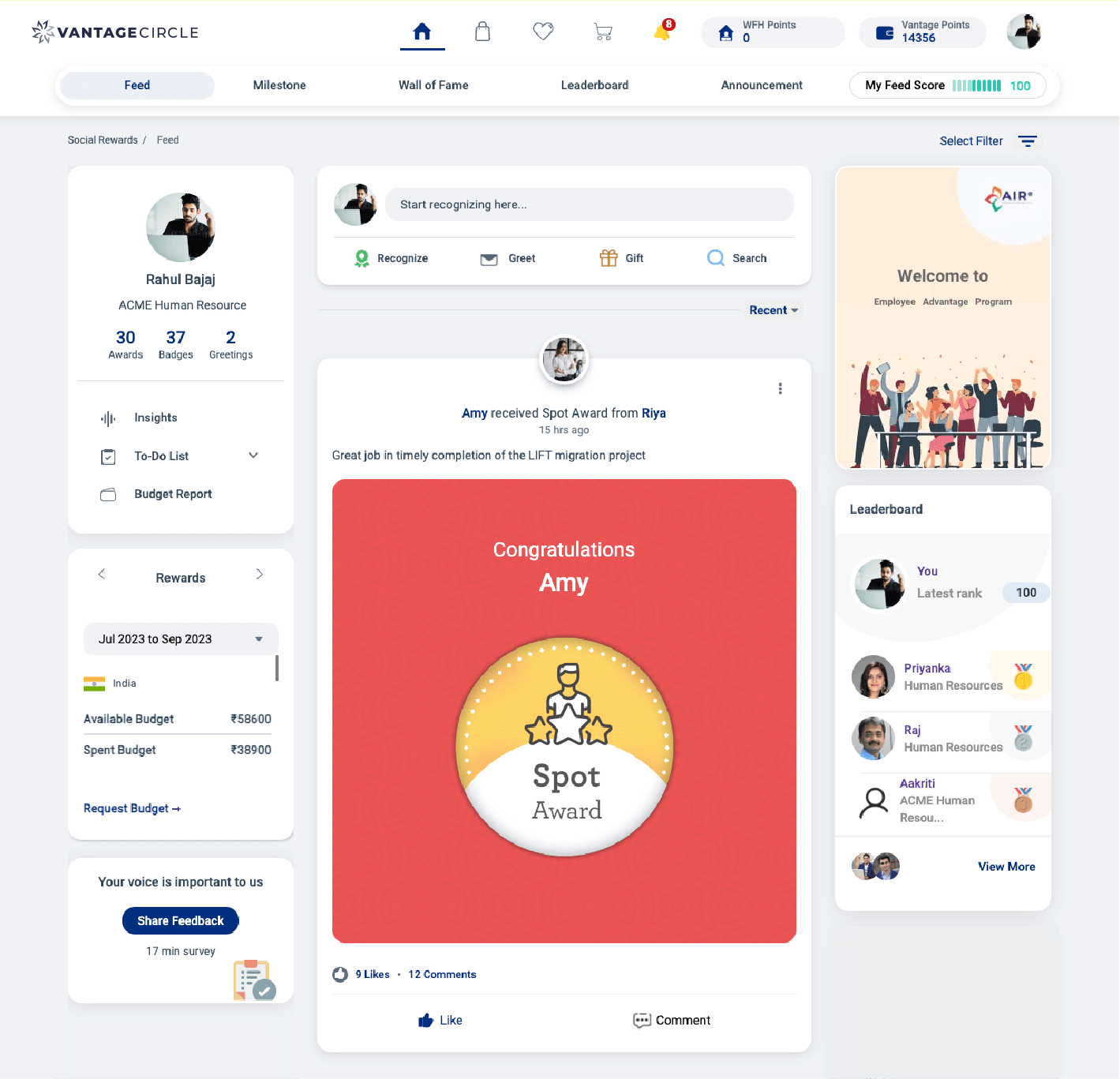
(Source: Vantage Circle)
This particular platform focuses on the rewarding process and enables employees to practice peer-to-peer recognition. Its recognize functionality allows the employees to instantly appreciate their colleagues for their contributions with just a few clicks. Furthermore, the platform enables an organization to improve its work culture and increase workplace recognition.
5. Get Creative With The Recognition Process

A peer-to-peer recognition process must be fun and should encourage employees to keep practicing it. But if the process becomes monotonous with time, then chances are that the employees will lose interest. And being the leader, you do not want that if implementing peer-to-peer recognition is your goal.
You must make things interesting for the employees so they love acknowledging their peers. And some things you can opt for include-
-
Use of customizable badges.
-
Option to personalize the recognition with messages.
-
The functionality to wish colleagues during a special occasion.
-
Ability to give redeemable points, which can be converted into gift cards.
This keeps the engagement level high and enables the employees to become open to ideas while recognizing them.
And to assist you with such ideas, use a platform that enables users to-
-
Wish their peers on time with its wish feature.
-
Recognize their peers instantaneously with its mobile accessibility.
-
Navigate through the platform with its simplified user interface.
-
Advocate the work culture with its social media sharing feature.
This ensures everything runs smoothly and the team's engagement levels are intact.
How To Set Up A Peer-To-Peer Recognition Program At Your Company

Before you start implementing your peer recognition program, it is crucial to understand how you will set it up. Such programs play a major role in improving the work culture, and it can be overwhelming if you do not have a strategic approach.
So, how are you going to do it? What are the things you need to remember before setting up a peer recognition program? Let’s have a look at the critical steps.
-
The first step is to define the goals and what you want to achieve with the program. This is essential to direct the program in the way you want it.
Now, to achieve the goals that you have set, you will need the help of virtual tools. So, you must choose the right tool that fits your culture and budget. -
The next step is to inform the workforce about the program and how you want to implement it. Hold orientation sessions to give a heads-up about everything so that you keep things transparent.
-
A successful recognition program is only achievable if you have the right leadership skills. Hence, it is important to preach what you say and practice recognition in every step you take so that the employees can learn from you.
-
To determine the program's success, measuring it, in the long run, is essential. And to do that, you have to monitor it timely so that you can keep track of the program and make improvements accordingly.
To know more about how you can implement a peer-to-peer recognition program, you can read it here.
How to Measure the Success of Your Peer-to-Peer Recognition Program

Measuring the success of a peer-to-peer recognition program is critical to ensuring that it achieves its goals and delivers tangible results. Several metrics and methodologies can be used to assess the efficacy of such a program:
1. Engagement Metrics:

-
Participation Rate: Track how many employees actively utilize the recognition platform or system. A high participation rate suggests that employees are involved in the program while valuing its importance.
-
Frequency: Get a detailed report on how frequently awards are given. Recognition regularly can indicate a sustained culture of gratitude.
2. Feedback and Surveys:

-
Employee Satisfaction: Survey employees to determine their satisfaction with the recognition program. Are they finding it useful and simple to use?
-
Perceived Fairness: Make certain that the recognition program is seen as fair and impartial. If there is any favoritism, it might have a negative impact on its overall effectiveness.
3. Turnover Rate:

One of the primary purposes of appreciation programs is to increase employee retention. Keep an eye on the company's turnover rate. A decline may indicate the program's positive influence, but other factors may also be at play.
Read more: High Employee Turnover: 7 Major Reasons (+How To Solve Them)
4. Productivity Metrics:

Employees who are recognized are more motivated and productive. To analyze the program's impact, compare productivity levels before and after implementation. It will give you a clear understanding of the effectiveness of the recognition program.
5. Quality of Work:

Keep track of work-quality data such as mistake rates, project completion times, and client satisfaction scores. Improvements in these areas could be attributed to increased morale due to acknowledgment.
6. Peer Feedback:

Allow employees to submit feedback on the praise they receive from their colleagues. This can provide qualitative insights into what's working and needs to be tweaked. This will give you the opportunity to make adjustments accordingly.
7. Program Usage Data:

Analyze digital recognition platforms' backend data. Which characteristics are the most popular? Which departments or teams are the busiest? This can provide insights into the program's success and potential areas for development.
8. Cultural Impact:

Assess how the program has impacted the company culture, which is more difficult to quantify. Has there been an improvement in collaboration? Is there a more positive atmosphere? To acquire information, hold focus group talks or interviews.
Peer-to-Peer Recognition Platforms You Must Try

There are a plethora of recognition platforms that you can try out according to your organizational needs. However, below are the top 5 that we think you must try it out.
1. Vantage Circle

Vantage Circle is a global employee engagement platform that uses artificial intelligence and machine learning to deliver easy-to-use and effective employee engagement solutions to HR. Among the many capabilities, peer-to-peer recognition is one of the unique functionalities it provides its users. Employees can acknowledge their peers with the help of different badges on the platform and spot award team members with just a click.
To know more, click here.
2. Bonusly

Bonusly is a fun and easy way to recognize all of your employees. Designed for users and admins, it includes peer-to-peer recognition tied to company values, automated celebrations for new hires, birthdays, work anniversaries, customizable awards, flexible survey tools, and an international reward catalog with a gift card, donations, and swag options.
To know more, click here.
3. WorkTango (Formerly Kazoo)

WorkTango's (previously Kazoo's) Recognition and rewards system amplifies and incentivizes essential values/behaviors through Social Recognition, Incentives, and Rewards, reinforcing business culture, improving alignment, and making employees feel more appreciated and engaged.
To know more, click here.
4. Kudos

Kudos is an employee recognition and rewards, culture, and analytics platform that leverages the power of peer-to-peer recognition, values reinforcement, and open communication to assist organizations in increasing employee engagement, decreasing attrition, improving culture, and driving productivity and performance.
To know more, click here.
5. Nectar
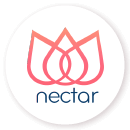
Nectar helps you create a culture people won't want to leave through consistent, meaningful peer-to-peer recognition & rewards. It helps you build a sense of community, evangelize core values, and connect people to each other and your company's mission.
To know more, click here.
Pointers for Leaders to Manage the Peer-to-peer Recognition Program
-
Ensure that everything related to the program is well-maintained beforehand so there are no hiccups in the long run.
-
Check for any bias that might occur during the recognition process. This is important to keep things balanced.
-
Ensure that everyone is well-informed about the program so that employees can indulge in it fully.
-
Conduct an orientation of the peer-to-peer recognition program where employees can grasp how everything works.
-
Explain the program's long-term benefits and how it will positively impact the organization's work culture.
Summing it Up!
We all know that employees are an integral part of an organization. In any high-performing company, peer-to-peer recognition forms an essential factor. It also helps build strong bonds in the workplace, which is vital for teamwork success.
Peer recognition positively impacts employee morale and helps them focus on their work. It has much more impact and becomes meaningful when employees get appreciated by their peers for their efforts.
The bottom line here is that leaders and HR professionals need to place a robust recognition and rewards program. It will improve employer branding in social media and increase the reputation among the target audience.
FAQ
Q. What is an example of peer-to-peer recognition?
A. Peer-to-peer appreciation occurs when one colleague publicly recognizes another colleague's great project performance during a team meeting, highlighting their vital contributions.
Q. How does peer-to-peer recognition differ from traditional top-down recognition?
A. Peer-to-peer recognition is originated and driven by colleagues at the same level within an organization, encouraging a more inclusive and real appreciation culture, as opposed to traditional recognition, which is often initiated and led by management.
Q. Is peer-to-peer recognition suitable for all types of organizations?
A. Yes, peer-to-peer recognition can benefit organizations of all sizes and industries, fostering employees' sense of belonging and motivation.
Q. What impact can peer-to-peer recognition have on company culture?
A. Peer-to-peer recognition can improve business culture by fostering openness, trust, and a feeling of community, leading to increased employee retention and happiness.
Q. Are there any potential challenges in implementing peer-to-peer recognition programs?
A. Resistance to change, uneven engagement, and the need for constant communication to retain excitement are all potential challenges.

















